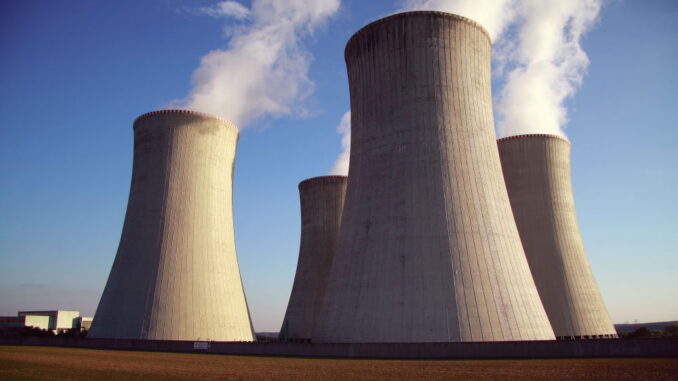
Favoring Failure
Finding a way to favor failure has been a consistent theme.
In the years since An Inconvenient Truth Gore has consistently and specifically championed weather-dependent wind and solar energy as the options that should replace carbon-emitting fuels. He makes a specific pitch for both near the end of the film.
But as noted, the first hour the movie is filled with gory warnings that the notoriously unpredictable weather will become even wilder still. And today he still preaches the weather is out to kill us all.
“I think these extreme events that are getting steadily worse and more severe are really beginning to change minds,” he said to NBC News in July 2022. He made the same point to ABC News, adding that “the survival of our civilization is at stake.”
So, according to the Nobel laureate, the planet’s weather is becoming dangerously crazy, and we must rely on this murderously unstable weather to provide our life-sustaining electricity.
George Orwell analyzed this school of thought in his novel 1984:
DOUBLETHINK, means the power of holding two contradictory beliefs in one’s mind simultaneously, and accepting both of them. The Party intellectual knows in which direction his memories must be altered; he therefore knows that he is playing tricks with reality; but by the exercise of DOUBLETHINK he also satisfies himself that reality is not violated.” [Emphasis in original]
Understanding Al Gore’s energy agenda requires harnessing the power of doublethink.
But even James Hansen can’t do it.
The former NASA scientist is far from a critic of Gore’s overheated apocalyptic warnings about the fate of the planet. In the summer of 1988, following the implosion of his presidential campaign, Gore went back to work in the Senate and invited Hansen to testify in a now famous public hearing about global warming.
The hearing elevated the public profile of both men and the issue. After years of trying, Gore had finally put climate policy at the center of American political debates. Two decades later, Hansen remained an ally, warmly praising An Inconvenient Truth as a “a coherent account of a complex topic that Americans desperately need to understand.”
But in a 2011 analysis the much-celebrated climate alarmist wrote. “Suggesting that renewables will let us phase rapidly off fossil fuels in the United States, China, India, or the world as a whole is almost the equivalent of believing in the Easter Bunny and Tooth Fairy.” Hansen concluded that renewables were “grossly inadequate for our energy needs now and in the foreseeable future.”
In 2015, The Guardian published an essay from Hansen and three other climate scientists titled “Nuclear power paves the only viable path forward on climate change.” Noting that France and Sweden were both able to “ramp up nuclear power to high levels in just 15–20 years,” Hansen and the others argued that a worldwide build rate of 115 new reactors annually was “technically achievable” and by 2050 would “entirely decarbonise the global electricity system.”
For Gore, failure was the option. In a 2020 TED Talk he dismissed nuclear energy as a “crushing disappointment.” This was not a new position for him. In a November 2000 statement released just days before his loss in the presidential election, Gore pandered to and thrilled anti-nuclear extremists with this statement: “I do not support any increased reliance on nuclear energy. Moreover, I have disagreed with those who would classify nuclear energy as clean or renewable.”
When Gore gave that TED Talk in 2020, nuclear energy was—by a healthy amount—the largest source of carbon-free energy consumed in the United States. As of 2021, nuclear kicked in 2,057 terawatt-hours of power, nearly equal to the combined output from wind, solar, and hydro-electric dams.
Nuclear energy’s dominance as America’s greatest source of carbon-free power was even more pronounced in November 2000, when Gore gave up on it, and has held true since at least the mid-1980s.
In March 2021, the U.S. Department of Energy declared nuclear the nation’s “largest source of clean power” and estimated that using nuclear rather than coal had removed the equivalent of 100 million carbon-emitting cars from the road. The Department of Energy also calculated that a “typical 1,000-megawatt nuclear facility” needed “a little more than 1 square mile to operate” yet did the work of 430 wind turbines or 3 million solar panels.
And with some . . . ahem . . . political leadership, the United States could have done far more with nuclear power and still could. In 2000, nuclear was—without even the “carbon free” qualifier—the largest source of power consumed in France, edging out even oil. By 2020, nuclear accounted for 36.6 percent of total energy consumed by the French, oil was a distant second at 30.5 percent, and nothing else was remotely close.
If these realities of nuclear power represent a “crushing disappointment” for carbon reduction and conservation of the natural environment, then it’s difficult to figure what could possibly ever make Gore happy.
The amazing technical marvel that is nuclear energy receives only a tangential mention in An Inconvenient Truth, when Gore announces that a nuclear-powered submarine took him on a trip underneath the North Pole. He doesn’t try to explain how this voyage could have been accomplished with a wind- or solar-powered boat. The effort might have won him another Oscar, though they would have needed a new category for “Best Comedy.”



